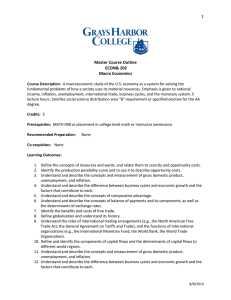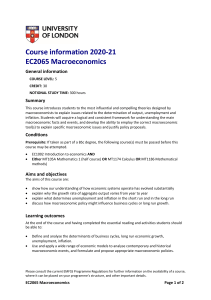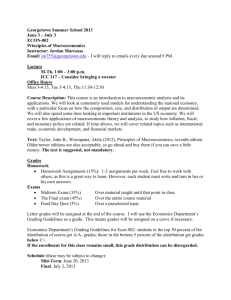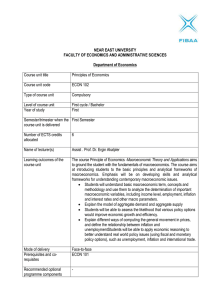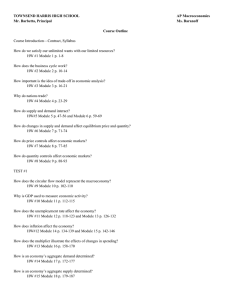Course Syllabi_ECO 104 - North South University
advertisement
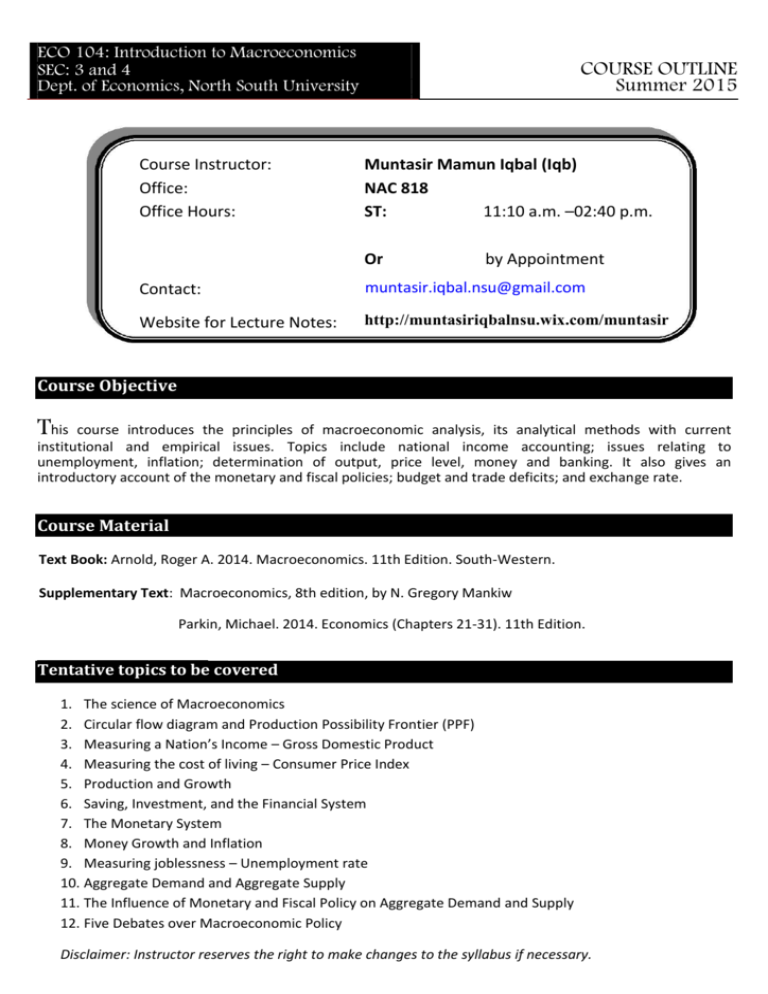
ECO 104: Introduction to Macroeconomics SEC: 3 and 4 Dept. of Economics, North South University Course Instructor: Office: Office Hours: COURSE OUTLINE Summer 2015 Muntasir Mamun Iqbal (Iqb) NAC 818 ST: 11:10 a.m. –02:40 p.m. Or by Appointment Contact: muntasir.iqbal.nsu@gmail.com Website for Lecture Notes: http://muntasiriqbalnsu.wix.com/muntasir Course Objective This course introduces the principles of macroeconomic analysis, its analytical methods with current institutional and empirical issues. Topics include national income accounting; issues relating to unemployment, inflation; determination of output, price level, money and banking. It also gives an introductory account of the monetary and fiscal policies; budget and trade deficits; and exchange rate. Course Material Text Book: Arnold, Roger A. 2014. Macroeconomics. 11th Edition. South-Western. Supplementary Text: Macroeconomics, 8th edition, by N. Gregory Mankiw Parkin, Michael. 2014. Economics (Chapters 21-31). 11th Edition. Tentative topics to be covered 1. The science of Macroeconomics 2. Circular flow diagram and Production Possibility Frontier (PPF) 3. Measuring a Nation’s Income – Gross Domestic Product 4. Measuring the cost of living – Consumer Price Index 5. Production and Growth 6. Saving, Investment, and the Financial System 7. The Monetary System 8. Money Growth and Inflation 9. Measuring joblessness – Unemployment rate 10. Aggregate Demand and Aggregate Supply 11. The Influence of Monetary and Fiscal Policy on Aggregate Demand and Supply 12. Five Debates over Macroeconomic Policy Disclaimer: Instructor reserves the right to make changes to the syllabus if necessary. ECO 104: Introduction to Macroeconomics SEC: 3 and 4 Dept. of Economics, North South University COURSE OUTLINE Summer 2015 Evaluation Criteria: Attendance & Class Participation: 3 Quizzes: (Best 2) 2 Midterm: Final Exam: 5% 20% (2 x 10%) 40% (2 x 20 %) 35% Student Learning Outcomes By successfully completing this course, students should be able to: 1. Outline the major macroeconomic problems and the key macroeconomic measures that can be used to identify these. 2. Compute and explain the basics of unemployment and inflation. 3. Apply both aggregate supply/demand analysis and Keynesian aggregate expenditure analysis to determine aggregate output. 4. Interpret the multiplier and its role. 5. Evaluate the role of fiscal and monetary policy in bringing about changes to aggregate output and the price level. 6. Explain the key factors that lead to economic growth. 7. Demonstrate a basic understanding of the costs and benefits of trade restrictions. Student Code of Conduct MAKE-UP EXAM There will be NO MAKE-UP EXAMS taken regardless of deaths, diseases, famine, civil war, burglary, sibling’s-wedding. If you do happen to miss an exam and can show legitimate reason, then after careful considerations I will transfer your missed exam grade distribution percentage to the final exam. o If you miss an exam, please submit a typed application stating reason for absence and requesting to sit for comprehensive final exam o Include your Name and ID in the application o Please note, having higher percentage of grade distribution because of any missed exam will only make your life harder, considering my final exam will be much more challenging comparatively to the quiz and the midterm. GENERAL INSTRUCTIONS Please make an attempt to come to class on time and have the courtesy to not leave before the lecture is over. You will NOT get the attendance marks if you arrive in class 10 mins after lecture starts. Put your phone on silent mode – if you must answer a very important call, quietly leave the room. Talking in class while a lecture is going on is very distracting and insulting to the facilitator. Please refrain from doing so. Feel free to ask questions in class or during my office hours if you fail to understand some concept. I will be happy to help you out.


